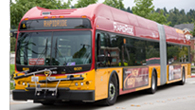April 12, 2012
Just in time: System improvements will help Metro meet rising demand
If you've filled your gas tank lately, you probably won't be surprised to hear that Metro's ridership is growing. High gas prices, along with SR-520 tolling and employment gains, are causing people to flock to transit. Metro's ridership grew almost 3 percent in 2011, and the trend is continuing this year.
It's critical to the region that Metro meet this growing demand.
That's one reason why our proposed September service changes, which the County Council will take up Monday, are hugely important.
We have proposed changes to more than 50 bus routes in Seattle and communities north and south of the city. This would be our largest service revision ever, involving one-quarter of the service hours in our system.
The plan we've put forward would add new connections, reduce duplicative and low-ridership service, improve the flow of buses in the congested Seattle core, and relieve overcrowding and boost reliability by shifting service hours to heavily used routes.

The changes would take effect Sept. 29, when the new RapidRide C and D lines start providing fast, frequent trips all day, seven days a week, between West Seattle, Ballard, and downtown Seattle. Most of the proposed revisions are designed to create a more effective transit network around the RapidRide backbone.
The recommended changes make better use of Metro's resources by focusing service where it's needed the most.
Our plan would move about 65,000 service hours from routes averaging 25.6 riders per hour to routes averaging 36.2 riders per hours. We estimate that we'll see at least 600,000 more boardings annually as a result.
With Metro facing both higher rider demand and an ongoing funding gap, that gain in productivity is essential to our long-term sustainability.
At the same time, we're making sure we serve communities where many people depend on public transit for getting around. Our approach is consistent with the landmark strategic plan for public transportation approved by the Council last summer, as well as the congestion reduction charge ordinance that directed us to make the system more efficient and effective.
The public had a say
A combination of objective service guidelines and community input shaped our proposal. After using the guidelines to develop initial ideas for service improvements, we gathered more than 10,000 comments from community members. We then modified or eliminated a number of our initial ideas based on what we heard.
Tradeoffs are inevitable. Some customers will have to add a transfer or travel a little farther to a bus stop as a result of what we're proposing. But our experience shows that by using both data and community input to restructure service, we can serve more people overall. Metro's service restructures since 2003 have resulted in ridership increases far and above the rate of ridership growth for the system as a whole.
The September restructure would follow the reinvestment of 36,000 annual service hours in June. And other big changes are set for Sept. 29: the end of the Ride Free Area in downtown Seattle and the start of “pay as you enter” systemwide. More about that later, but for now it's worth noting that pay-on-entry will make Metro simpler to use for new riders as well as our regulars.
Altogether, Metro is getting a major overhaul that will help us meet rising demand by leading to a more productive, effective and easier-to-use transit system.
Sincerely,
Kevin Desmond, General Manager
King County Metro Transit
Rob Gannon
General Manager, King County Metro Transit

If you live in King county, Metro is your public transportation system. I want you to know about our performance and the innovative service improvements we’re bringing your way.
Visit here often to read my newsletter, or sign up to receive it by e-mail.

